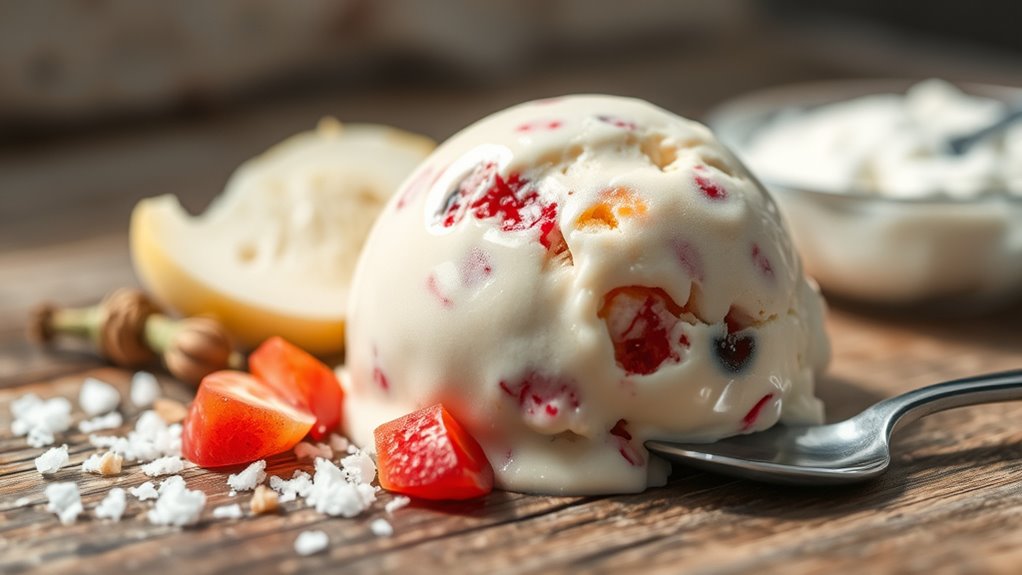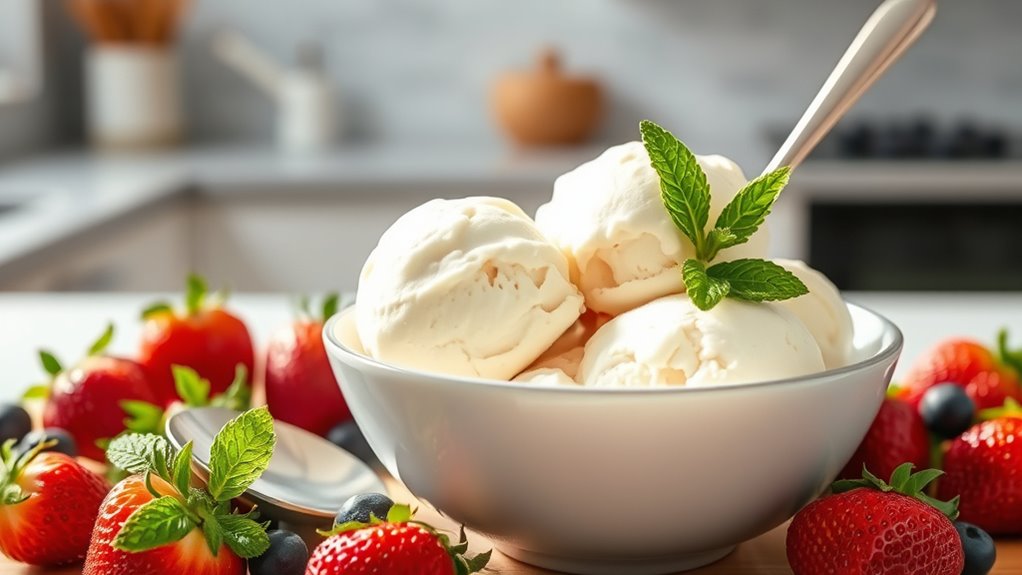Sugar-free ice cream might seem like a healthy choice, but it’s packed with artificial sweeteners like aspartame and sucralose that have raised health concerns. These sweeteners can potentially lead to weight gain, disrupt gut bacteria, and pose risks for certain populations. Plus, calorie counts can still be significant. While the taste can mimic traditional ice cream, understanding these ingredients is essential. There’s more to uncover about the implications of these sweeteners on your health.
Key Takeaways
- Sugar-free ice cream often contains artificial sweeteners like aspartame and sucralose, which are significantly sweeter than sugar but may have health implications.
- Some studies link artificial sweeteners to potential weight gain and metabolic issues, despite their calorie-free nature.
- Sugar-free options can disrupt gut bacteria, potentially leading to insulin sensitivity problems in certain populations.
- Taste tests show that sugar-free ice cream can be equally palatable to traditional ice cream, thanks to advancements in formulation techniques.
- Moderation is essential when consuming sugar-free ice cream, as artificial sweeteners may still pose health risks, especially for sensitive groups like pregnant women.
Common Artificial Sweeteners in Sugar-Free Ice Cream

When you’re enjoying sugar-free ice cream, it’s often sweetened with a variety of artificial sweeteners.
You’ll commonly find aspartame, which is 200 times sweeter than sugar, and sucralose, known for its use in products like Splenda. Sugar-free vanilla ice cream is a popular choice among those seeking healthier treats, and many of these options are low-carb alternatives that align with dietary goals. Ice cream is a beloved treat, with an average consumption of about 23 pounds annually per person in the U.S.
Neotame, similar to aspartame, offers a unique metabolic pathway with an ADI of 0.3 mg/kg body weight/d.
Saccharin, one of the first artificial sweeteners, can sometimes leave a bitter aftertaste.
Acesulfame potassium is another choice, as it’s stable for cooking and blends well with other sweeteners. Chia seeds, which are rich in omega-3 fatty acids, can also be used as a natural sweetening alternative in some recipes.
Acesulfame potassium is a versatile sweetener, ideal for cooking and harmonizing with other flavor enhancers.
Manufacturers often combine these sweeteners with sugar alcohols, like erythritol, to achieve a satisfying texture and taste. This mix provides the sweetness you crave without the calories, making it a popular choice for those looking to indulge guilt-free.
Health Impacts of Artificial Sweeteners

Although many people enjoy the sweetness of sugar-free ice cream, the health impacts of artificial sweeteners can be a concern. Research links these sweeteners to increased risks of cardiovascular diseases, metabolic disorders, and even potential weight gain despite being calorie-free. You might find that they disrupt your gut bacteria, leading to insulin sensitivity issues and inflammation. Additionally, artificial sweeteners are generally considered safe but should be used in moderation. Certain populations, including pregnant women and those with specific health conditions, may be more vulnerable to adverse effects. Consuming high levels of antioxidants from fruits and vegetables can help mitigate some negative effects. For instance, incorporating freshly squeezed juices into your diet can provide essential nutrients that may counteract the adverse impacts of artificial sweeteners. Interestingly, the use of solar energy systems can align with a sustainable lifestyle, much like choosing healthier food options. While health agencies deem them safe within limits, it’s essential to stay informed. As you indulge in sugar-free treats, consider these potential health implications and monitor your overall consumption for a balanced approach to your diet. Furthermore, incorporating fiber-rich foods like chia seeds into your meals can support gut health and improve digestion, countering some negative effects associated with artificial sweeteners.
Taste and Consumer Acceptance

Sugar-free ice cream has gained popularity as more people seek healthier dessert options, and its taste has become a central factor in consumer acceptance. Many find that artificial sweeteners can replicate sugar’s sweetness, making sugar-free versions just as satisfying as traditional ice cream. Including whole foods in desserts can enhance their nutritional value, which complements the trend towards healthier eating. Moreover, incorporating ingredients like baked kale can add unique flavors and nutritional benefits.
Familiar flavors like vanilla and chocolate are particularly well-received, thanks to their versatility. While some sensory challenges exist due to sugar’s essential role in texture and taste, technological advances are improving formulations to better mimic traditional ice cream. The global sugar-free ice cream market is expected to grow at a CAGR of around 8.9%, driven by increasing health consciousness and demand for low-sugar diets. Additionally, understanding financial considerations for elderly care can help consumers make informed choices about healthier options that fit their budgets. Furthermore, as individuals aim to enhance their retirement savings, they may explore strategic withdrawal timing to manage expenses on healthier desserts.
Blind taste tests reveal that no-added-sugar options can be equally palatable, shifting public perception towards greater acceptance. As health awareness grows, you might find yourself more inclined to try these tasty alternatives.
Nutritional Content of Sugar-Free Ice Cream

The nutritional content of sugar-free ice cream varies considerably, making it essential to read labels before indulging.
The nutritional content of sugar-free ice cream can vary widely; always read labels before enjoying.
You’ll typically find calorie counts ranging from 110 to 272 per serving. While these treats are sugar-free, they often contain high-fat ingredients like full-fat milk, contributing greatly to the overall fat content. Interestingly, some varieties, like no sugar added ice cream, can have a low calorie density of 96 calories per 100g, which may aid in portion control. It’s important to note that some artificial sweeteners can lead to emotional manipulation in consumers who may overindulge thinking they are making healthier choices. Additionally, many consumers are increasingly drawn to sustainable fashion options, reflecting a broader trend towards health-conscious and eco-friendly products. Furthermore, regular consumption of high-fat treats like ice cream can lead to increased heart disease risk over time. Understanding the importance of budgeting for treats can also help manage overall health and finances.
Carbohydrates can range from 13 to 28 grams, including sugar alcohols or sweeteners, with net carbs sometimes reaching around 22 grams. Protein levels are generally low, around 2 to 5 grams, and fiber is often minimal.
Some versions may offer beneficial nutrients like calcium and potassium, but watch out for possible health concerns linked to artificial sweeteners. Always check the ingredient list to make informed choices.
Manufacturing and Formulation Insights

When creating sugar-free ice cream, manufacturers face unique challenges that require innovative solutions to guarantee quality and taste. They start with homogenization and pasteurization to assure a smooth texture and eliminate bacteria. Incorporating sweeteners like aspartame or sucralose alongside ingredients like skimmed milk powder and polydextrose helps achieve the desired sweetness and consistency. Additionally, using coconut milk, heavy cream, and powdered sweetener allows for a natural formulation without added sugars. This process is similar to high-quality brewing capabilities used in espresso machines, ensuring a satisfying end product. Freezing techniques, often at -40°C, play a vital role in establishing hardness. Additionally, stabilizers and emulsifiers maintain the ice cream’s texture, similar to how butter washing is used to remove buttermilk in butter production. The aging process, cooling the mix to around 5°C, enhances flavor and texture. The importance of color accuracy in visual presentations can also be likened to ensuring the right balance of flavors in ice cream. Balancing sweetness levels and flavor profiles can be tricky, but with careful formulation, manufacturers can deliver a satisfying product that competes with traditional ice cream. Using fresh ingredients can also elevate the overall taste and nutritional value of the ice cream.
Healthier Alternatives and Lifestyle Considerations

With growing health consciousness, many people are seeking alternatives to traditional ice cream that fit their dietary needs. Homemade banana ice cream, for instance, blends frozen bananas for a low-fat, naturally sweet treat. Coconut milk ice cream offers a dairy-free option sweetened with natural alternatives like agave. If you’re looking for lower calories, frozen yogurt and sorbet provide delicious options without the guilt. Gelato presents a rich flavor with less air, reducing saturated fat and sugar content. Large indoor plants can also be a great addition to your kitchen space, promoting a healthier environment while you enjoy your ice cream. Additionally, consider adding chia seeds to your dessert for a nutritious boost.
Remember to take into account calorie counts and ingredient quality when choosing sugar-free options. Opt for natural sweeteners like honey or maple syrup, and don’t forget to add nuts or fruits for extra nutrition. Moderation is key, even with healthier alternatives.
Frequently Asked Questions
Are Artificial Sweeteners Safe for Children?
Are artificial sweeteners safe for children? While regulatory bodies like the FDA approve some sweeteners, caution is advised.
Current recommendations suggest that children’s intake generally stays within safe limits, but mixed research results raise concerns about potential impacts on health and nutrition.
You should monitor your child’s consumption, as long-term effects aren’t fully understood. Ensuring a balanced diet is key, and consider discussing artificial sweeteners with a healthcare professional for personalized advice.
Can Sugar-Free Ice Cream Cause Digestive Issues?
Imagine indulging in a delicious dessert, only to find your stomach churning like a roller coaster.
Yes, sugar-free ice cream can cause digestive issues. Many of these treats contain sugar alcohols, which might lead to bloating, gas, or even diarrhea.
If you’ve ever felt queasy after a sweet treat, it could be those ingredients at play.
Pay attention to your body’s signals—sometimes, what seems like a guilt-free option can turn into an uneasy ride!
Do Artificial Sweeteners Affect Dental Health?
Artificial sweeteners can impact your dental health in both positive and negative ways. They inhibit the growth of harmful bacteria, helping prevent tooth decay.
However, some sugar-free products contain acids that can erode tooth enamel.
So, while using sweeteners like xylitol can benefit your teeth, it’s important to consume products in moderation and maintain good oral hygiene.
Regular dental check-ups are also essential to monitor any changes in your oral health.
How Do Artificial Sweeteners Interact With Medications?
It’s funny how something as small as a sweetener can impact your medications.
Artificial sweeteners can interact with your drugs in various ways. For instance, they might alter enzyme levels, changing how your body absorbs and metabolizes medication.
They can also modify your gut microbiome, which plays a role in drug effectiveness.
With limited human studies, it’s essential you stay informed about these potential interactions to guarantee your medications work as intended.
Are There Long-Term Studies on Artificial Sweeteners?
Yes, there are long-term studies on artificial sweeteners. Researchers have explored their effects on body fat, metabolism, and overall health.
Some studies suggest a link between artificial sweeteners and obesity, diabetes, and cardiovascular issues. While regulatory bodies consider them safe, ongoing research is essential to fully understand their long-term impacts.
You should stay informed about these findings, as they could influence your choices regarding artificial sweeteners in your diet.
Conclusion
In the world of sugar-free ice cream, you might find yourself asking: is the sweetness worth the trade-offs? While artificial sweeteners can cut calories, they come with their own set of questions about health and taste. As you explore alternatives, consider what truly satisfies your cravings—after all, enjoying a treat shouldn’t feel like a compromise. Making informed choices can lead you to a delicious balance between indulgence and well-being. So, what’s your scoop?










